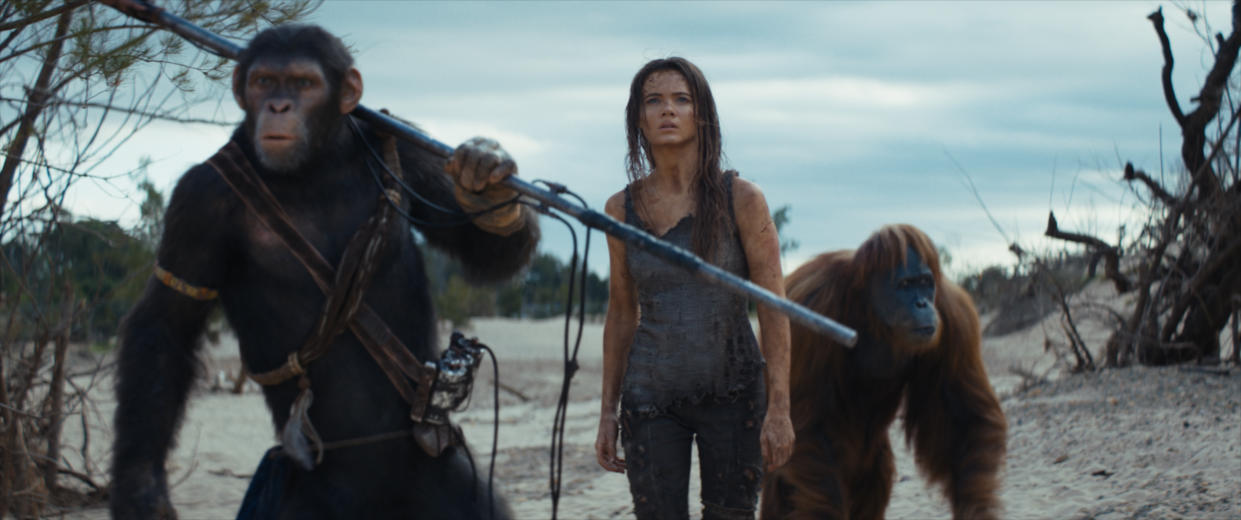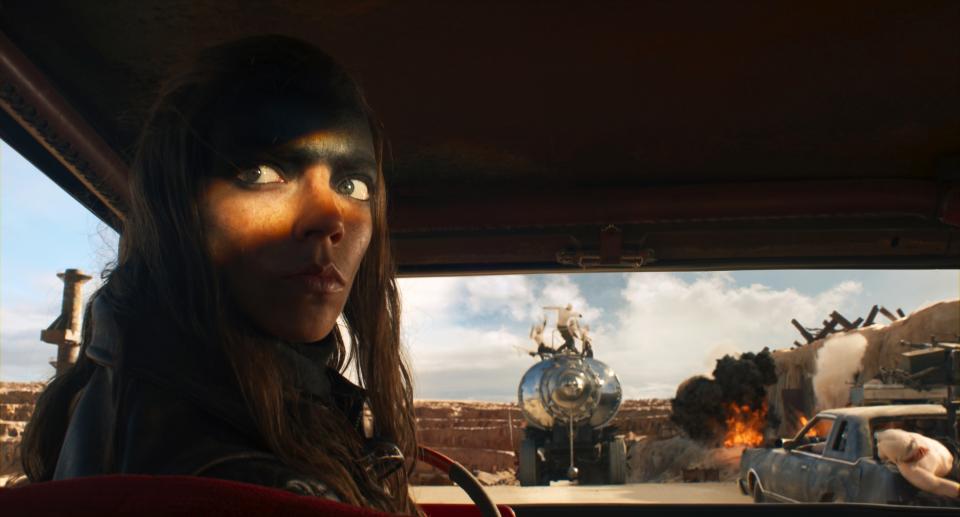2025 Oscars: Best Visual Effects Predictions

Nominations voting is from January 8-12, 2025, with official Oscar nominations announced January 17, 2025. Final voting is February 11-18, 2025. And finally, the 97th Oscars telecast will be broadcast on Sunday, March 2 and air live on ABC at 7:00 p.m. ET/ 4:00 p.m. PT. We update our picks through awards season, so keep checking IndieWire for all our 2025 Oscar predictions.
The State of the Race
Wes Ball’s “Kingdom of the Planet of the Apes” (20th Century Studios), which kicks off the post-Caesar saga 300 years later, is the early Oscar favorite. While the franchise has yet to win, Wētā FX greatly improved its photoreal performance capture animation and VFX, leveraging its tech from the previous “Apes” trilogy and water simulation from the Oscar-winning “Avatar: The Way of Water.”
More from IndieWire
How 'Trigger Warning' Tweaks the Military Revenge Thriller for a New Era
In 'Despicable Me 4,' Director Chris Renaud Got to Go Full Superhero Vibes with Mega Minions
Wēta used dual-camera facial rigs to capture the detail and emotion of the ape performances (led by Owen Teague’s Noa and Kevin Durand’s Proximus Caesar) with greater fidelity. They also refined tools for muscle simulation, facial animation, grooming, water simulations, painting textures, shaders, and rendering to create more realistic and chattier apes. In addition, Wētā embraced more expansive environments, with the simians developing their own civilization in villages spread throughout the overgrown Pacific Northwest (shot in New South Wales, Australia). The highlights are the early siege of Noa’s village, the homage to “The Hunt” from the 1968 original, and the thrilling rushing water sequence.
The strongest competition will come from “Dune: Part 2” (Warner Bros.), which director Denis Villeneuve made more exciting and emotional with Paul (Timothée Chalamet) leading the nomadic Fremen in a holy war on Arrakis. VFX supervisor Paul Lambert and his Oscar-winning “Dune” DNEG team ramped up everything with a lot more visceral action, particularly with Paul and the Fremen riding the massive CG sandworms into battle against the Sardaukar.
The highlight is Paul riding atop the sandworm for the first time to complete his Fremen rite of passage. It was shot practically in the desert as part of a separate “worm” unit and took more than three months to complete. Chalamet stood on a platform with gimbals designed by SFX supervisor Gerd Nefzer as the sandworm set piece, with gripping devices imitating the Fremen hooks, and surrounded by an industrial fan that blew sand on the set. Also, for a challenging sequence showing the movement of a baby sandworm, they used a very sophisticated tracking system with carpets under the sand.

George Miller’s “Furiosa: A Mad Max Saga” (Warner Bros.) utilized more CG in post than its predecessor, “Fury Road,” for this thrilling prequel about the titular hero’s badass rite of passage. She’s played by Alyla Browne as a child and teenager and Anya Taylor-Joy as an adult, with Rising Sun Pictures using AI machine learning software to make Browne’s eyes more resemble Anya Taylor-Joy’s.
Returning production VFX supervisor Andrew Jackson from DNEG oversaw more realistic fire, water, dust, and smoke. The VFX team extended the Wasteland desert landscape and skies and embellished the newly created Gas Town and Bullet Town environments. Plus, they were able to replace or augment the iconic vehicles (especially the multitude of motorcycles) for the action set pieces, the highlight of which was the 15-minute “Stowaway to Nowhere” sequence, where raiders ambush the War Rig driven by Praetorian Jack (Tom Burke) and Furiosa 15-minute “Stowaway to Nowhere” sequence, where raiders ambush the War Rig driven by Praetorian Jack (Tom Burke) and Furiosa.
Lee Isaac Chung’s “Twisters” (Universal) puts storm chasing rivals Kate (Daisy Edgar-Jones) and Tyler (Glen Powell) in the middle of Oklahoma’s most terrifying ordeal. ILM (which worked on the 1996 “Twister”) returns for the update, led by production VFX supervisor Ben Snow, who was an artist on the original movie. They took actual storm footage assets captured by professional storm chaser Sean Casey and created six tornado sequences. These had a design aesthetic combining physics with a stylistic flourish, and was accomplished through both practical SFX and digital VFX.
Alex Garland’s “Civil War” (A24) dystopian actioner, which was handled by Framestore, required a VFX look to complement the film’s gritty, doc-style aesthetic, capturing as much in-camera as possible. The studio (led by production VFX supervisor David Simpson), created 1,000 invisible VFX shots, most of which centered on the climactic attack on Washington DC (shot in Atlanta), including the White House. The environment work was detailed down to each building having different lighbulbs, internal office furniture and, desk clutter, all of it feeling recently abandoned.

“Godzilla x Kong: The New Empire” (Warner Bros.) featured work by Wētā, Scanline VFX, DNEG, and Luma Pictures, among others. The titular monsters got a subtle upgrade while Wētā created the new Kong adversary Skar King, the cunning, lanky, red-haired orangutan-like creature, who lords over the subterranean realm of Hollow Earth. They overhauled the design concept to ensure his biomechanics worked in line with the desired motion and also roughed him up, complete with a cat-eye reflection in one of his eyes.
David Leitch’s “The Fall Guy” (Universal), his loving ode to stunt performers (inspired by the ’80s TV series), boasted a record-breaking cannon roll, a 225-foot car jump, a helicopter high fall, and a boat jump by the stunt team. Ryan Gosling stars as an ace stuntman trying to make a comeback on a sci-fi actioner directed by former girlfriend Emily Blunt, while at the same time solving the mysterious disappearance of Aaron Taylor-Johnson’s lead actor. The invisible VFX (production VFX supervised by Matt Sloan) was handled by Framestore, Cinesite, Rising Sun Pictures, and Crafty Apes as an ’80s retro throwback, honoring the legacy of the practical stunts with a hybrid approach that enhances the action.
Michael Sarnoski’s “A Quiet Place: Day One” (Paramount) prequel, in which Sam (Lupita Nyong’o) is on a mission to grab the last slice of pizza in Manhattan while under attack by the alien creatures, offers a greater range of animated creature work and variation in size from ILM (production supervised by Malcolm Humphreys). There’s also more of a hint at how they survive as a social group. Whereas the creatures disposed of bodies very quickly in the first two movies, here we witness how they communicate, how they eat, and how they relate to each other.
As for the rest: Fede Álvarez’s “Alien: Romulus” (20th Century Studios), a standalone set between “Alien” and “Aliens,” concerns young colonists who encounter the parasitic Xenomorphs while scavenging a derelict space station. In a throwback to the original, the trailer shows the creepy facehugger attaching itself to Aileen Wu. ILM joins Image Engine, Tippett Studio, and Wētā, among others (production supervised by Oscar winner Eric Barba of “The Curious Case of Benjamin Button”).
Shawn Levy’s “Deadpool & Wolverine” (Marvel/Disney) reunites Ryan Reynolds’ Deadpool and Hugh Jackman’s Wolverine for the first time as part of the R-rated “Deadpool” franchise within the MCU. The time-bender involves the TVA (Time Variance Authority) and introduces baddie Cassandra Nova (Emma Corrin), the mutant with telekinetic and telepathic powers and the twin sister of Charles Xavier. TVA agent Paradox (“Succession’s” Matthew Macfadyen) is also new. VFX is mainly divided between ILM, Framestore, Wētā, and Rising Sun Pictures (production supervised by Swen Gillberg). Among ILM’s contributions (supervised by Vincent Papaix) were complex CG extensions and FX simulation, and lots of FX gore and CG character work.
“Mufasa: The Lion King” (Disney) might seem like a stretch for “Moonlight” Oscar winner Barry Jenkins, but this animated origin story about the rise of Mufasa (Aaron Pierre) to nobility is dear to his heart, and the director has tamed the photorealistic tech to suit his vision. This prequel to Jon Favreau’s innovative remake of “The Lion King” (nominated for the VFX Oscar) once again contains keyframe animation by MPC, but Jenkins is not looking to emulate a Nat Geo doc with virtual production, and has embraced a more nuanced emotional approach to character performances.
Ridley Scott’s “Gladiator 2” (Paramount), the sequel to his Oscar-winning “Gladiator,” introduces a new generation of warriors starring Paul Mescal as Lucius Verus, the former heir to the Empire, Denzel Washington as Macrinus, a former slave-turned-wealthy merchant, and Pedro Pascal as Marcus Acacius, a former Roman general forced to fight as a gladiator. Framestore and ILM do primary VFX honors with Mark Bakowski serving as production supervisor.
Jon Chu’s “Wicked” (Universal), the long-awaited adaptation of the Broadway musical fantasy by Stephen Schwartz and Winnie Holtzman, concerns the origin story of Elphaba Thropp (Cynthia Erivo), the misunderstood young woman born with green skin, who eventually becomes the Wicked Witch of the West. ILM and Framestore again split VFX duties for the “Oz”-inspired character and environment work, with Pablo Helman of ILM serving as production supervisor.
Robert Zemeckis’ “Here” (Sony Pictures) marks the latest cutting edge VFX film in the Oscar-winning director’s career. Adapted from the influential graphic novel by Richard McGuire, the drama concerns all the inhabitants of a single room within a house during the span of a century. It reunites the director with his “Forrest Gump” co-stars Tom Hanks and Robin Wright, who play a boyfriend and girlfriend in their teens during the Vietnam War and eventually marry and grow old together. Zemeckis has adopted a virtual production methodology around Metaphysic Live, the generative AI software from Metaphysic, which face-swaps and de-ages the actors in real time as they perform, instead of relying on post-production processing. DNEG is handling the VFX with long-time Zemeckis collaborator Kevin Baillie supervising the production.
Tim Burton’s “Beetlejuice Beetlejuice” (Warner Bros.), the sequel to his horror comedy, sees Michael Keaton’s foul-mouth ghoul get accidentally returned from the afterlife to torment the Deetz family 36 years later. Winona Ryder and Catherine O’Hara also return and are joined by newcomers Jenna Ortega, Justin Theroux, Monica Bellucci, Arthur Conti, and Willem Dafoe. VFX is being split by Framestore, One of Us, and BUF, with Framestore’s Angus Bickerton serving as production supervisor.
Joachim Rønning’s “Young Woman and the Sea” (Disney) contains noteworthy water simulation by MPC (production supervised by Richard Briscoe) for the swimming biopic about Trudy Ederle (Daisy Ridley), the first woman to successfully swim the English Channel in 1926. Calm water plates were enhanced with digital ocean replacements in key places. This involved complex, multi-layered FX simulations to try and capture the natural movement and texture of the choppy waters in the Channel. In addition, for a dangerous swim through a smack of jellyfish, MPC integrated the CG creatures into live-action plates for precise compositing and animation.
Potential nominees are listed in alphabetical order; no film will be deemed a frontrunner until we have seen it.
Frontrunners
“Civil War”
“Dune: Part Two”
“Furiosa: A Mad Max Saga”
“Kingdom of the Planet of the Apes”
“Twisters”
Contenders
“A Quiet Place — Day One”
“Alien: Romulus”
“Beetlejuice Beetlejuice”
“Deadpool & Wolverine″
“Gladiator 2”
“Godzilla x Kong: The New Empire”
“Here”
“Mufasa: The Lion King”
“The Fall Guy”
“Wicked”
“Young Woman and the Sea”
Best of IndieWire
2023 Emmy Predictions: Who Will Win at the Primetime Emmy Awards?
2023 Emmy Predictions: Outstanding Documentary or Nonfiction Special
2023 Emmy Predictions: Outstanding Documentary or Nonfiction Series
Sign up for Indiewire's Newsletter. For the latest news, follow us on Facebook, Twitter, and Instagram.


